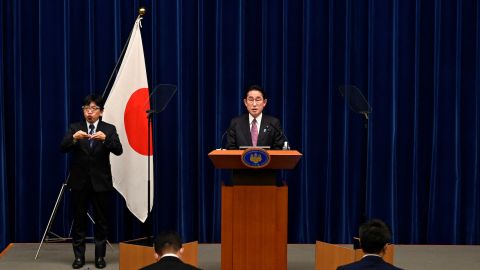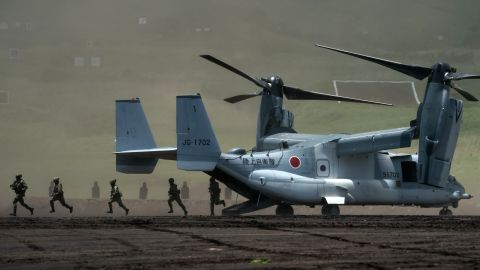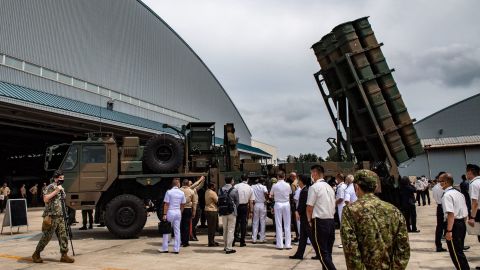Japan on Friday unveiled a new national security plan that signals the country’s biggest military buildup since World War II, doubling defense spending and veering from its pacifist constitution in the face of growing threats from regional rivals.
In an early evening televised address in Tokyo, Prime Minister Fumio Kishida said the government had approved three security documents – the National Security Strategy (NSS), the National Defense Strategy, and the Defense Force Development Plan – to bolster Japan’s defense capabilities amid an increasingly unstable security environment.
The new measures include provisions that would enable Japan to possess “counterstrike capabilities,” the ability to directly attack another country’s territory in the event of an emergency and under specific circumstances, Kishida said.
The Prime Minister earlier in December instructed his defense and finance ministers to secure funds to increase Japan’s defense budget to 2% of current GDP in 2027, according to Defense Minister Yasukazu Hamada.
In taking the new defense initiatives, Japan is bending the interpretation of its post-World War II constitution, which put constraints on its Self-Defense Forces in that they can only be used for what their name implies, defending the Japanese homeland.
But Tokyo is facing its most hostile security situation in decades.
With its defense overhaul, Japan describes one of those rivals – China – as its “biggest strategic challenge,” public broadcaster NHK reported Friday.
Long-time rival China has been been growing its naval and air forces in areas near Japan while claiming the Senkaku Islands, an uninhabited Japanese-controlled chain in the Sea of Japan, also known as the East Sea, as its sovereign territory.
Chinese ships have been making frequent forays near the islands, which it calls the Diaoyus, while Japan scrambles warplanes almost daily in response to Chinese planes nearing its airspace.

Meanwhile, China has been upping its military pressure on Taiwan, the self-ruled island whose security Japanese leaders have said is vital to the security of Japan itself. In August, that pressure included Beijing firing five missiles that landed in Japan’s exclusive economic zone near Taiwan in response to the visit of US House Speaker Nancy Pelosi to Taipei.
From its west, Japan has been watching the buildup of North Korea’s missile arsenal. Pyongyang has tested missiles on 34 occasions this year, including firing one over Japan in October for the first time in five years, an act Kishida called “outrageous.”
To the north of Japan, a Russian buildup on islands there since the beginning of the war in Ukraine and bellicose rhetoric from Moscow has only added to the apprehension in Tokyo that it may need to defend its territories from several threats at once.
While Japan is regarded to have one of the world’s most modern and powerful militaries, its weaponry has been designed to strike enemies near its islands. But the new defense strategy, which public broadcaster NHK said earlier this week would give Tokyo arms like US-made Tomahawk missiles, that could strike the bases from which possible foes like China, North Korea or Russia could strike Japanese territory.
According to Self-Defense Force officials, Japan’s current missile defense systems can only engage an incoming target once it comes within range of about 31 miles (50 kilometers). But China, for instance, has missiles that can be launched from a wide range of warplanes from distances as far away as 186 miles (300 kilometers).
Tokyo says any new long-range weapons it may acquire would not be “first strike” weapons, but would only be used if a foe first attacked Japan.
Support from Washington
Tokyo’s new defense strategy drew praise from its No. 1 ally, the United States, which shares a mutual defense treaty with Japan and is pledged to defend Japanese territory from attack. The United States also operates several large military installations in Japan, including Yokosuka Naval Base, home to the US Navy’s 7th Fleet.
“We welcome the release of Japan’s updated strategy documents … which reflect Japan’s staunch commitment to upholding the international rules-based order and a free and open Indo-Pacific,” US Secretary of Defense Lloyd Austin said in a statement.
“We support Japan’s decision to acquire new capabilities that strengthen regional deterrence, including counterstrike capabilities,” Austin said.
Experts say Japanese forces are vital to any potential US military operations against China should hostilities break out.

“The Japanese military is incredibly capable. … In a time of large-scale conflict in East Asia, including a possible conflict in the Taiwan Strait, Japan would have a very important and capable role to play,” said Ankit Panda, a Stanton senior fellow in the nuclear policy program at the Carnegie Endowment for International Peace.
“Japan will be a very important partner especially for the United States, in a moment of conflict in East Asia.”
Given the scope of the changes to Japanese defense policy, the country’s main opposition party on Friday said Kishida hadn’t done enough to talk through the changes with them.
“There has been no provision of information, no explanations, and no discussion with the public or the Diet, even though we are deciding on things that will significantly change Japan’s post-war security policy,” Kenta Izumi, head of the Constitutional Democratic Party of Japan, said at a press conference.
Stoking an Asian arms race
But Panda and others have warned there are no checks on what is a fast-paced arms race in Asia – and that fuels regional instability.
“I think this will continue to intensify threat perceptions in both Pyongyang and Beijing. And we’ll continue to see these dynamics spiral in East Asia. Where we have no measures of restraint. We have no arms control,” Panda said.
As reports of the Japanese defense buildup have surfaced over the past few months, China has warned Tokyo of possible consequences of increasing its military power.

In a regular press briefing in early December, China’s Foreign Ministry accused Japan of “hyping up regional tensions to seek military breakthroughs,” and said Japan needs to “earnestly reflect on its history of aggression, respect the security concerns of Asian neighbors, act prudently in the field of military security, and do more things that are conductive to regional peace and stability.”
An editorial in the Chinese state-run tabloid Global Times on Wednesday blasted the new security policy even before it was unveiled.
“The signal it releases is undoubtedly very dangerous,” it said.
“Using this to guide the national security strategy will definitely lead Japan into a dangerous and barbaric drift, and the end is a huge dark vortex. We advise Japan to take it easy,” Global Times said.
The Taiwan question
Much of the tensions between China and Japan center on Taiwan. For more than 70 years the two sides have been governed separately, but that hasn’t stopped China’s ruling Communist Party from claiming the island as its own – despite having never controlled it.
Last December, the late former Japan Prime Minster Shinzo Abe proclaimed that “a Taiwan emergency is a Japanese emergency, and therefore an emergency for the Japan-US alliance,” calling on Chinese leader Xi Jinping to “never make a misjudgment” on this – a statement that reverberated across East Asia.
But analysts say it wasn’t until China launched military drills around Taiwan in August and fired those missiles into Japan’s exclusive economic zone that Tokyo really sat up and took notice of Beijing’s designs on the island.
“It was a wake-up call,” according to professor Kuo Yu-Jen of Taiwan’s National Sun Yet-Sen University who specializes in Japan defense policy. “It drew their attention and concern to how Taiwan’s security is relevant to Japan’s own security.”
Given Taiwan’s strategic location on the first island chain – a string of US-friendly territories crucial to US foreign policies – and alongside a key global shipping lane, were the island to fall under Beijing’s control, it could potentially jeopardize Japan’s economic lifeline and give China’s navy unfettered access to the Western Pacific.
“Japan’s position is clear and steadfast – Taiwan is fundamental to its own security; it is not merely a stress point in its bilateral relations with China,” Yasuhiro Matsuda, an international politics professor at University of Tokyo and a former Defense Ministry senior researcher, told CNN.
CNN’s Tetsu Sukegawa contributed to this report.
World - Latest - Google News
December 16, 2022 at 07:59PM
https://ift.tt/e8fPNsK
Japan approves long-range weapons to counter growing threats from rivals - CNN
World - Latest - Google News
https://ift.tt/KGlcJBu
https://ift.tt/QfFvxem
Bagikan Berita Ini
















0 Response to "Japan approves long-range weapons to counter growing threats from rivals - CNN"
Post a Comment